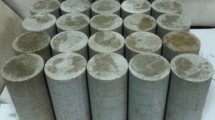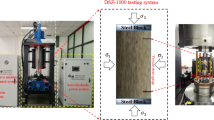Abstract
This study performed uniaxial compression tests and cyclic gradient loading tests with both an increasing and a constant lower stress limit on cracked sandstone. Test results showed how the different cyclic loading modes changed deformation modulus, energy dissipation, and crack coalescence modes in the cracked sandstone samples. For the rock deformation analysis, a deformation modulus was used to explain why a sample with a smaller crack inclination angle underwent less deformation when subjected to the same cyclic loading path. The tests showed that, compared with uniaxial compression, the two kinds of cyclic loading increased the specimen’s deformation modulus. Under cyclic gradient loading with an increasing lower stress limit, the dissipated energy densities of the samples show a “step-like” increased, and the overall growth trend is roughly logarithmically. However, for the other cyclic loading path with a constant lower stress limit, the samples’ dissipated energy densities increased exponentially as the number of cycles increased. In addition, a block energy dissipation density rate K was defined, and the deformation of the samples before fracture instability could be divided into stages defined by K. In terms of crack coalescence modes, six crack types were defined. The comparison and analysis of the test results according to these defined crack types showed that, compared with uniaxial compression, cyclic loading increased the number and types of cracks that developed in the rock samples and more surface spalling occurred.













Similar content being viewed by others


References
Aliha MRM, Ayatollahi MR (2013) Two-parameter fracture analysis of SCB rock specimen under mixed mode loading. Eng Fract Mech 103:115–123. https://doi.org/10.1016/j.engfracmech.2012.09.021
Bagde MN, Petroš V (2005) Fatigue properties of intact sandstone samples subjected to dynamic uniaxial cyclical loading. Int J Rock Mech Min Sci 42(2):237–250. https://doi.org/10.1016/j.ijrmms.2004.08.008
Bagde MN, Petroš V (2009) Fatigue and dynamic energy behaviour of rock subjected to cyclical loading. Int J Rock Mech Min Sci 46(1):200–209. https://doi.org/10.1016/j.ijrmms.2008.05.002
Bobet A, Einstein HH (1998) Fracture coalescence in rock-type material under uniaxial and biaxial compression. Int J Rock Mech Min Sci 35(7):863–888. https://doi.org/10.1016/S0148-9062(98)00005-9
Fuenkajorn K, Sriapai T, Samsri P (2012) Effects of loading rate on strength and deformability of Maha Sarakham salt. Eng Geol 135–136:10–23. https://doi.org/10.1016/j.enggeo.2012.02.012
Gong F, Luo S, Yan J (2018) Energy storage and dissipation evolution process and characteristics of marble in three tension-type failure tests. Rock Mech Rock Eng 51:3613–3624. https://doi.org/10.1007/s00603-018-1564-4
Gong F, Si X, Li X, Wang S (2019a) Dynamic triaxial compression tests on sandstone at high strain rates and low confining pressures with split Hopkinson pressure bar. Int J Rock Mech Min Sci 113:211–219. https://doi.org/10.1016/j.ijrmms.2018.12.005
Gong F, Yan J, Li X, Luo S (2019b) A peak-strength strain energy storage index for bursting proneness of rock materials. Int J Rock Mech Min Sci 117:76–89. https://doi.org/10.1016/j.ijrmms.2019.03.020
Gong F, Yan J, Luo S, Li X (2019c) Investigation on the linear energy storage and dissipation laws of rock materials under uniaxial compression. Rock Mech Rock Eng 52:4237–4255. https://doi.org/10.1007/s00603-019-01842-4
Jia C, Xu W, Wang R, Wang W, Zhang J (2018) Characterization of the deformation behavior of fine-grained sandstone by triaxial cyclic loading. Constr Build Mater 162:113–123. https://doi.org/10.1016/j.conbuildmat.2017.12.001
Kovari K, Tisa A, Einstein H (1983) Suggested methods for determining the strength of rock materials in triaxial compression: revised version. Int J Rock Mech Min Sci Geomech Abstr 20(6):285–290. https://doi.org/10.1016/0148-9062(83)90598-3
Liang W, Zhao Y, Xu S, Dusseault M (2011) Effect of strain rate on the mechanical properties of salt rock. Int J Rock Mech Min Sci 48(1):161–167. https://doi.org/10.1016/j.ijrmms.2010.06.012
Liu M, Liu E (2017) Dynamic mechanical properties of artificial jointed rock samples subjected to cyclic triaxial loading. Int J Rock Mech Min Sci 98:54–66. https://doi.org/10.1016/j.ijrmms.2017.07.005
Liu Y, Dai F, Dong L (2018) Experimental investigation on the fatigue mechanical properties of intermittently jointed rock models under cyclic uniaxial compression with different loading parameters. Rock Mech Rock Eng 51:47–68. https://doi.org/10.1007/s00603-017-1327-7
Liu Y, Dai F, Fan P (2017) Experimental investigation of the influence of joint geometric configurations on the mechanical properties of intermittent jointed rock models under cyclic uniaxial compression. Rock Mech Rock Eng 50(6):1453–1471. https://doi.org/10.1007/s00603-017-1190-6
Luo K, Zhao G, Zeng J, Zhang X, Pu C (2018) Fracture experiments and numerical simulation of cracked body in rock-like materials affected by loading rate. Chin J Rock Mech Eng 37(8):1833–1842. https://doi.org/10.13722/j.cnki.jrme.2018.0080
Martin CD, Christiansson R, Söderhäll J (2001) Rock stability considerations for siting and constructing a KBS-3 repository. Based on experiences from Aespoe HRL, AECL's URL, tunnelling and mining
Meng Q, Zhang M, Han L, Pu H, Nie T (2016) Effects of acoustic emission and energy evolution of rock specimens under the uniaxial cyclic loading and unloading compression. Rock Mech Rock Eng 49:3873–3886. https://doi.org/10.1007/s00603-016-1077-y
Momeni A, Karakus M, Khanlari GR (2015) Effects of cyclic loading on the mechanical properties of a granite. Int J Rock Mech Min Sci 77:89–96. https://doi.org/10.1016/j.ijrmms.2015.03.029
Peng K, Zhou J, Zou Q, Zhang J, Wu F (2019a) Effects of stress lower limit during cyclic loading and unloading on deformation characteristics of sandstones. Constr Build Mater 217:202–215. https://doi.org/10.1016/j.conbuildmat.2019.04.183
Peng K, Wang Y, Zou Q, Liu Z, Mou J (2019b) Effect of crack angles on energy characteristics of sandstones under a complex stress path. Eng Fract Mech 218:106577. https://doi.org/10.1016/j.engfracmech.2019.106577
Peng K, Liu Z, Zou Q, Zhang Z, Zhou J (2019c) Static and dynamic mechanical properties of granite from various burial depths. Rock Mech Rock Eng 52:3545–3566. https://doi.org/10.1007/s00603-019-01810-y
Peng K, Shi S, Zou Q, Mou J, Yu J, Zhang Y, Cheng Y (2020) Characteristics of energy storage and dissipation of coal under one-time cyclic load. Energy Science & Engineering 1–19. https://doi.org/10.1002/ese3.738
Wasantha PLP, Ranjith PG, Zhao J (2015) Strain rate effect on the mechanical behaviour of sandstones with different grain sizes. Rock Mech Rock Eng 48(5):1883–1895. https://doi.org/10.1007/s00603-014-0688-4
Wong LNY, Einstein HH (2009) Systematic evaluation of cracking behavior in specimens containing single flaws under uniaxial compression. Int J Rock Mech Min Sci 46(2):239–249. https://doi.org/10.1016/j.ijrmms.2008.03.006
Wong LNY, Li HQ (2013) Numerical study on coalescence of two pre-existing coplanar flaws in rock. Int J Solids Struct 50:3685–3706. https://doi.org/10.1016/j.ijsolstr.2013.07.010
Wang Z, Li S, Qiao L et al (2013) Fatigue behavior of granite subjected to cyclic loading under triaxial compression condition. Rock Mech Rock Eng 46(6):1603–1615. https://doi.org/10.1007/s00603-013-0387-6
Xiao JQ, Ding DX, Jiang FL et al (2010) Fatigue damage variable and evolution of rock subjected to cyclic loading. Int J Rock Mech Min Sci 47(3):461–468. https://doi.org/10.1016/j.ijrmms.2009.11.003
Xie HP, Ju Y, Li LY (2005) Criteria for strength and structural failure of rocks based on energy dissipation and energy release principles. Chin J Rock Mechan Eng 24(17):3003–3010
Xie H, Li L, Peng R (2009) Energy analysis and criteria for structural failure of rocks. J Rock Mech Geotech Eng 1:11–20. https://doi.org/10.3724/sp.j.1235.2009.00011
Yang SQ, Dai YH, Han LJ, Jin ZQ (2009) Experimental study on mechanical behavior of brittle marble samples containing different flaws under uniaxial compression. Eng Fract Mech 76:1833–1845. https://doi.org/10.1016/j.engfracmech.2009.04.005
Yang SQ, Jing HW (2011a) Strength failure and crack coalescence behavior of brittle sandstone samples containing a single fissure under uniaxial compression. Int J Fract 168(2):227–250. https://doi.org/10.1007/s10704-010-9576-4
Yang SQ (2011b) Crack coalescence behavior of brittle sandstone samples containing two coplanar fissures in the process of deformation failure. Eng Fract Mech 78:3059–3081. https://doi.org/10.1016/j.engfracmech.2011.09.002
Zhang XP, Wong LNY (2012) Cracking processes in rock-like material containing a single flaw under uniaxial compression: a numerical study based on parallel bonded-particle model approach. Rock Mech Rock Eng 45:711–737. https://doi.org/10.1007/s00603-011-0176-z
Zhang XP, Wong LNY (2013) Loading rate effects on cracking behavior of flaw-contained specimens under uniaxial compression. Int J Fract 180:93–110. https://doi.org/10.1007/s10704-012-9803-2
Zou CJ, Wong LNY (2014) Experimental studies on cracking processes and failure in marble under dynamic loading. Eng Geol 173:19–31. https://doi.org/10.1016/j.enggeo.2014.02.003
Zou Q, Liu H, Zhang Y et al (2020a) Rationality evaluation of production deployment of outburst-prone coal mines: a case study of Nantong coal mine in Chongqing, China. Saf Sci 122:104515. https://doi.org/10.1016/j.ssci.2019.104515
Zou Q, Liu H, Cheng Z et al (2020b) Effect of slot inclination angle and borehole-slot ratio on mechanical property of pre-cracked coal: implications for ECBM recovery using hydraulic slotting. Nat Resour Res 29(3):1705–1729. https://doi.org/10.1007/s11053-019-09544-y
Zhou ZL, Cai X, Li XB, Cao WZ, Du XM (2020) Dynamic response and energy evolution of sandstone under coupled static–dynamic compression: Insights from experimental study into deep rock engineering applications. Rock Mech Rock Eng 53:1305–1331. https://doi.org/10.1007/s00603-019-01980-9
Acknowledgements
The authors also thank the editor and anonymous reviewers very much for their valuable advice.
Funding
This work was funded by the National Natural Science Foundation of China (72088101, 52074041, 51974043, and 51774058), the Basic Scientific Research Operating Expenses of Central Universities (2020CDJQY-A048 and 2020CDJ-LHZZ-002), and Natural Science Foundation of Chongqing, China (cstc2020jcyj-msxmX0836).
Author information
Authors and Affiliations
Corresponding authors
Rights and permissions
About this article
Cite this article
Peng, K., Wang, Y., Zou, Q. et al. Experimental study of energy dissipation characteristics and crack coalescence modes of cracked sandstone under different cyclic loading paths. Bull Eng Geol Environ 80, 5881–5895 (2021). https://doi.org/10.1007/s10064-021-02290-7
Received:
Accepted:
Published:
Issue Date:
DOI: https://doi.org/10.1007/s10064-021-02290-7


